Tupolev Tu-142
| Tu-142 | |
|---|---|
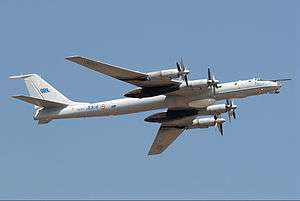 | |
| A Tu-142 of the Indian Naval Air Arm in-flight at the 2007 Aero India | |
| Role | Maritime patrol and anti-submarine warfare aircraft |
| National origin | Soviet Union Russia |
| Design group | Tupolev |
| Built by | Kuibyshev Aviation Plant Taganrog Machinery Plant |
| First flight | 18 July 1968[1] |
| Introduction | December 1972[1] |
| Status | Out of production, in service |
| Primary users | Soviet Navy (historical) Russian Navy Indian Naval Air Arm Ukrainian Air Force (historical) |
| Produced | 1968–1994[2] |
| Number built | 100[2] |
| Developed from | Tupolev Tu-95 |
The Tupolev Tu-142 (Russian: Туполев Ту-142; NATO reporting name: Bear F/J) is a maritime reconnaissance and anti-submarine warfare (ASW) aircraft derived from the Tu-95 turboprop strategic bomber. A specialised communications variant designated Tu-142MR was tasked with long-range communications duties with Soviet ballistic missile submarines. The Tu-142 was designed by the Tupolev design bureau, and manufactured by the Kuibyshev Aviation and Taganrog Machinery Plants from 1968 to 1994. Formerly operated by the Soviet Navy and Ukrainian Air Force, the Tu-142 currently serves with the Russian and Indian Naval Air Arm.
Developed in response to the American Polaris programme, the Tu-142 grew out of the need for a viable Soviet ASW platform. It succeeded the stillborn Tu-95PLO project, Tupolev's first attempt at modifying the Tu-95 for maritime use. The Tu-142 differed from the Tu-95 in having a stretched fuselage to accommodate specialised equipment for its ASW and surveillance roles, a reinforced undercarriage to support rough-field capability, improved avionics and weapons, and enhancements to general performance. The Tu-142's capability was incrementally improved while the type was in service, eventually resulting in the Tu-142MZ, the final long-range Tu-142 with highly sophisticated combat avionics and a large payload. Tupolev also converted a number of Tu-142s as avionics (Tu-142MP) and engine (Tu-142LL) testbeds.
Design and development
Early designs
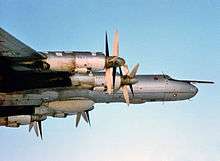
In the late 1950s the US Navy developed the UGM-27 Polaris, a submarine-launched ballistic missile (SLBM) with a range of more of than 1,800 kilometres (1,000 nm).[4] The Navy test-fired rocket boosters to perfect the design, culminating in the first underwater launch of a ballistic missile by USS George Washington on 20 July 1960. Polaris became operational on 15 November that year, when the George Washington left Charleston, South Carolina, with a complement of nuclear-armed Polaris missiles.[5]
The Soviet government consequently ordered Tupolev and other aircraft design bureaus to study possible dedicated anti-submarine warfare (ASW) designs. Tupolev initially designed the Tu-95PLO (protivolodochnaya oborona, or ASW), a development of the Tu-95 equipped with sonobuoys, anti-submarine mines and torpedoes. It was to carry a 9,000 kg (19,841 lb) payload with a maximum loiter time of 10.5 hours.[6] The design was dropped, however, because it lacked a powerful radar, thermal imaging (infrared) system and magnetic anomaly detector (MAD).[6] On 28 February 1963, the Council of Ministers (the highest executive and administrative body of the Soviet Union) issued a directive to Tupolev requiring his bureau to develop a long-range ASW aircraft.[7]
The resultant design was named Tu-142 and had features in common with the Tu-95RT. The ventral and dorsal gun turrets were removed, as was the large dielectric radome housing the Uspeh radar system, which was replaced by a thermal imaging system located in a smaller fairing.[1] This left the tail turret with twin 23-mm AM-23 cannons, along with electronic countermeasures, as the only defensive armament.[8] The aircraft's search-and-targeting system featured Berkut (Golden Eagle) 360° radar.[7] A complex navigation system was integrated with the weapons targeting system.[7] Structural differences included an airfoil change to the wing, expanding its area to 295 m2 (3,172 ft2). The area of the elevators was increased by 14%, and improved hydraulic actuators were fitted. Metal fuel tanks replaced rubber bladders. To allow the Tu-142 to operate from semi-prepared runways, the Tu-95's four-wheel main undercarriage bogies were replaced with six-wheel units; the main undercarriage fairings were also modified.[9][10]
The first Tu-142 (construction number 4200) was built at the Kuibyshev Aviation Plant in Samara. It performed its first flight on 18 June 1968, with test pilot I. K. Vedernikov at the controls, taking off from Zhukovsky Airfield southeast of Moscow.[9][11] Early testing indicated that the fuselage needed to be lengthened by at least 1.5 m (4.9 ft) to accommodate new combat equipment. Therefore, the second prototype (c/n 4201) joined the flight-test programme on 3 September with a 1.7-metre (5.6 ft) front fuselage stretch, a modification found on all subsequent Tu-142s.[11] The third and final development Tu-142 entered flight test on 31 October, complete with the full equipment suite.[12] In May 1970, the Soviet Naval Aviation (AV-MF) – the air arm of the Soviet Navy – began receiving production Tu-142s for operational trials.[13]
Improved variants
| Production | Factory | AM-VF | NATO |
|---|---|---|---|
| approx. 12 | Tu-142 | Tu-142 | "Bear F" |
| 6 | Tu-142 | Tu-142 | "Bear F" Mod. 1 |
| N/A | Tu-142M | Tu-142 | "Bear F" Mod. 2 |
| approx. 43 | Tu-142MK | Tu-142M | "Bear F" Mod. 3 |
| N/A | Tu-142MZ | Tu-142MZ | "Bear F" Mod. 4 |
| N/A | Tu-142MR | Tu-142MR | "Bear J" |
| | |||
During early operations, the Tu-142 revealed several shortcomings. The aircraft's rough-field capability was found to be of limited use, so the two six-wheel bogies used on the first 12 of 36 aircraft were replaced with four-wheel reinforced bogies from the Tu-114 airliner; consequently, the wheel-wells in the engine nacelle were made slimmer.[14] These changes, along with the deletion of the thermal imaging system and parts of the electronic countermeasure (ECM) equipment, reduced the empty weight by 4,000 kg (8,818 lb).[14] The modified aircraft also introduced a crew rest area for long-duration missions, and was assigned the codename ("Bear F" Mod 1); from 1968 to 1972 the Kuibyshev Plant produced a total of 18 Tu-142s.[1][14][15]
In the early 1970s, production of Tu-142s was switched to the Taganrog Machinery Plant near the Black Sea. It has been speculated that the change to the idle plant was to give employment to the workers there.[15] The move required many improvements to the plant and the surrounding area, including the establishment of new assembly shops, the installation of new machinery and tooling, the re-training of the workforce, and the building of a new airfield.[15] Preparation took place until 1975, when production of the first Tu-142 began.[15] The Tu-142s built by Taganrog incorporated the changes found on the last of the Kuibyshev aircraft. Differences included a 30-centimetre (12 in) stretch to the front fuselage and a redesigned cockpit. Additional changes included new two-axle main undercarriage bogies. This version was given the factory designation Tu-142M, which was not adopted by the Soviet Navy; NATO codenamed it "Bear-F" Mod 2.[15][16]

As the 1970s progressed, silencing technology in submarines rendered acoustic-band sonobuoys and trigger devices ineffective. During 1961 and 1962, the Soviet Union conducted research and development into an explosive sound system (ESS) – used to locate deep-diving submarines – under the name Udar (Blow). In 1965, work had started on sonobuoy systems using ESS to be integrated with the Berkut radar. The programme was postponed when one of the aircraft intended to carry it, the Ilyushin Il-38, was found to be incompatible.[17] The developments instead resulted in the Udar-75, which was featured in a new search and targeting system (STS) of the Taganrog-built Tu-142Ms.[18]
A new target acquisition system dubbed Korshun-K, the cornerstone of which was the Korshun (Kite) radar, was installed on all subsequent Tu-142s. This system was used for detecting surfaced and submerged submarines, communicating with other ASW aircraft and ground bases, and performing navigational and tactical tasks.[19] The first three Tu-142Ms were the first aircraft to be equipped with this system, and thus were redesignated Tu-142MK ("Bear F" Mod. 3). It was the first Tu-142 to feature a MAD, its MMS-106 Ladoga system being mounted in an aft-facing fairing atop the vertical stabiliser.[19] The first of three Tu-142MKs that underwent Stage A of the trials programme made its first flight on 4 November 1975; despite the dismal performance figures, a production go-ahead was given.[19] Stage B, conducted during April–October 1978, found that the aircraft's avionics were extremely unreliable; like Stage A, these problems were apparently ignored when a directive issued on 19 November 1980 cleared the Tu-142MK for operational service.[20]
Technological upgrades
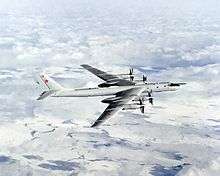
Even as the Tu-142MK entered service, its Korshun-K STS was already becoming obsolete. Work began on yet another improved Tu-142, resulting in the Tu-142MZ ("Bear F" Mod. 4) with the Korshun-KN-N STS. This consisted of Nashatyr-Nefrit (Ammonia/Jade) ASW avionics, which included the Zarechye sonar system.[21] As well as the RGB-1A and RGB-2 buoys of the Berkut, the Tu-142MZ was compatible with the RGB-16 and RGB-26 buoys. When working with the ASW avionics, these buoys provided 50% greater coverage.[21] The Kuznetsov NK-12MV were replaced by the more-powerful NK-12MP engines, and for the first time, the Tu-142 had an independent engine-starting capability with the addition of the TA-12 auxiliary power unit.[22] This variant was distinguished from earlier "Bear Fs" by the chin fairings housing several antennas.[22]
The flight test programme started in 1985 with the maiden flight of a converted Tu-142M fitted with the advanced avionics; state acceptance trials began within two years.[23] Test results proved excellent, as the aircraft successfully tracked nuclear-powered submarines of the Northern and Pacific Fleets.[23] The aircraft became operational with Russian Naval Aviation (AV-MP) in 1993. The last Tu-142MZ rolled off the Taganrog production line the following year, bringing an end to a 26-year production run during which 100 Tu-142s were produced.[2][23]
A communications variant designated Tu-142MR ("Bear J") was the last production version of the Tu-142. It was tasked with long-range communications duties with Soviet ballistic missile submarines, a role similar to that of the Boeing E-6 Mercury. The Tu-142MR differed from the ASW Tu-142s in having less-sophisticated avionics, but had a long trailing wire radio aerial to relay messages to submerged Soviet submarines in times of nuclear war. This was amongst the many distinctive features of the Tu-142MR that allows it to communicate with satellites, airborne and ground-based command posts, and submarines.[24][25] The aircraft replaced the Ilyushin Il-80 in the airborne command and control role. Tu-142s are currently operated by the 76th Naval Aviation Regiment from Kipelovo.[25] Other developments of the Tu-142 include the one-off Tu-142MRT maritime reconnaissance variant, and the unbuilt Tu-142MS missile-carrying variant.[26]
Operational history
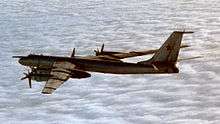
To prepare for Tu-142 operations, on 22 June 1960 the Soviet Navy began selecting personnel for conversion training.[15] The first group began its three-month training period on 4 March 1970 at the seaside town of Nikolayev (since renamed Mykolaiv).[15] Meanwhile, the first Tu-142s were delivered to the Northern Fleet at Kipelovo AB, where they were initially tasked with tracking and monitoring nuclear-powered submarines as part of the type's operational trials. Throughout the test programme, effort focused on the verification of the ASW avionics, notably the Berkut-95 radar, as the airframe itself was not a major concern.[27] The Tu-142 reached initial operational capability in December 1972 after a successful flight-test programme.[1] Prior to that, in December 1971, the second group selected for Tu-142 operations started its own conversion training.[15] Deliveries of the aircraft at first proceeded slowly; as more Tu-142s were produced, the type was allocated to the Pacific Fleet.[14]
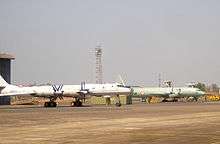
Throughout its operational history, the Tu-142 demonstrated significant capabilities. On 19–22 August 1974, four Tu-142s shadowed a foreign submarine in the Barents Sea; one of the aircraft was reported to have maintained continuous contact for 2 hours and 55 minutes.[28] In 1975, a Tu-142 managed to trail a Soviet submarine for 3 hours and 16 minutes.[28] On 10 October 1977, a group of five Tu-142s tracked a US submarine in the Philippine Sea; one of the Tu-142s reportedly trailed the submarine for 4 hours and 5 minutes.[28] Soviet Tu-142s, besides operating domestically, were sent to friendly overseas bases in Angola, Cuba, Ethiopia, Vietnam, and Yemen.[29] In the early 1990s, with the dissolution of the Soviet Union, the Soviet fleet of Tu-142s was handed to the Russian Navy, although the Ukrainian Air Force gained a few Tu-142s that had been left in its territory.[30] Ukrainian Tu-142s were later dismantled as a result of the bilateral START I treaty signed between the United States and the Soviet Union in 1991, which came into effect in late 1994.[31]
Besides the Tu-142's military applications, a one-off Tu-142MP was used to test a new ASW suite.[23] Another Tu-142 was converted to replace the Tu-95LL for the testing of turbojet engines. Designated Tu-142LL, the ASW equipment and armament were removed to allow an engine test bed to be carried under the belly. Some of the engines installed were the NK-25 for the Tu-22MZ, RD36-51A for the Tu-144D, and the NK-32 for the Tu-160.[32] The first Tu-142MK was converted for an airborne laboratory role, setting several altitude-in-horizontal and time-to-altitude records in its class.[32]
In 1981 the Indian Navy began considering a long-range maritime reconnaissance and anti-submarine warfare aircraft for its Naval Air Arm. The Soviet Union initially offered to refurbish some of its own Tu-142s for India, rather than construct new aircraft.[33] The Indian Navy was at first hesitant about the large Tu-142, which was heavy and thus would require runways to be reinforced and lengthened at potential operating bases.[33] Consequently, the service requested three Ilyushin Il-38s – then being phased out of service with the Soviet Navy – be refurbished for Indian operations. This request fell through, and so in December 1984 an agreement to purchase eight Tu-142s was signed.[33]
For the twelve-month period stating from May 1987, the Indian Navy sent 40 pilots and observers, 16 technical officers and 128 sailors to Riga for training.[33] On 30 March 1988, the first three Tu-142s arrived at the Indian naval air station of INS Hansa, Goa, after a flight from Simferopol(Gvardeyskoye Air Base) in the Crimean peninsula. On 13 April two more aircraft arrived, prior to the commissioning of INAS 312, the operator of Indian Tu-142s; by the end of October the fleet of eight Tu-142s was delivered.[33] In May 1992, the squadron was relocated to its current operating base at INS Rajali on the Indian east coast.[33] The Tu-142s are expected to be replaced by twelve smaller Boeing P-8Is.[34][35]
Variants
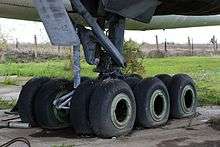
- Tu-142
- A lengthened Tu-95 with much defensive armament removed, and instead incorporating ASW systems. Twelve aircraft initially had 12-wheel main undercarriage bogies. Six later aircraft had four-wheel bogies. Built by Kuibyshev Aviation Plant.[36]
- Tu-142M
- A 30-centimetre (12 in) stretch to front fuselage, redesigned cockpit and two-axle main undercarriage bogies. Built by Taganrog.[16]
- Tu-142MK
- Greatly improved variant with new Korshun radar, avionics and ASW equipment. 43 Tu-142MKs were constructed by Taganrog.[37]
- Tu-142MK-E
- Eight downgraded Tu-142MKs purchased by the Indian Naval Air Arm. E stands for "export".[38]
- Tu-142MZ
- The last production variant of the "Bear F", with new NK-12MP engines and a new avionics suite. Can be distinguished from other Tu-142s by its chin fairings. Built by Taganrog.[36]
- Tu-142MZ-K
- Proposed commercial cargo variant of the Tu-142MZ (the K standing for "kommercheskiy"), with ASW avionics removed. Also designated Tu-142MZ-C.[23]
- Tu-142MP
- Modified single Tu-142M used as avionics testbed.[25]
- Tu-142MR
- Modified Tu-142MKs built as submarine communications relay aircraft. Has distinctive external fairings and components. NATO codename "Bear J".[25]
- Tu-142LL
- Two converted earlier Tu-142s used for testing of turbofan engines. ASW equipment was removed.[39]
Operators
- The Indian Naval Air Arm had 8 Tu-142MKEs in service as of December 2010, based at INS Rajali, Arakkonam, Tamil Nadu.[40]
- The Russian Naval Aviation had 15 Tu-142s in service as of December 2010.[40]
- Former
 Soviet Union
Soviet Union
- The Soviet Naval Aviation's Tu-142s were distributed between the Russian Naval Aviation and Ukrainian Air Force following the collapse of the Soviet Union.
- The Ukrainian Air Force inherited an unknown number of Tu-142s following the collapse of the Soviet Union. These were dismantled in accordance with the START I agreement.[31]
Notable accidents
On 7 November 2009, eleven crew were killed when their Tu-142 crashed over the Strait of Tartary near Japan during a training flight. Flights of aircraft belonging to the Pacific Fleet were suspended pending an investigation into the crash.[41] There was no indication that the crew made use of emergency equipment, although a lifeboat on board the plane was fitted with a device that transmits a signal in the event of an accident.[42] Chief of the General Staff Nikolay Makarov believed an engine failure could have caused the crash.[43] A memorial service was held for the crew on 16 December 2009.[44] A search for the bodies of the eleven crew members was suspended several times due to ice floes and bad weather.
Specifications (Tu-142MZ)
Data from Donald and Lake[45]
General characteristics
- Crew: 11–13
- Length: 53.08 m (162 ft 5 in)
- Wingspan: 50.00 m (167 ft 8 in)
- Height: 12.12 m (39 ft 9 in)
- Wing area: 311.10 m² (3,348.76 ft²)
- Empty weight: 90,000 kg (198,000 lb)
- Max. takeoff weight: 185,000 kg (407,848 lb)
- Powerplant: 4 × Kuznetsov NK-12MP turboprops, 11,033 kW (14,795 shp) each
Performance
- Maximum speed: 925 km/h (500 kt, 575 mph)
- Cruise speed: 711 km/h (384 kt, 442 mph)
- Combat radius: 6,500 km (3,454 nmi, 3,977 mi)
- Service ceiling: 12,000 m (39,000 ft)
References
Citations
- 1 2 3 4 5 Eden 2004, p. 488.
- 1 2 3 Friedman 2006, p. 164.
- ↑ [http://www.bharat-rakshak.com/NAVY/Aviation/Aircraft/119-Tupolev-Tu142 m.html "Tupolev Tu-142M"]. Bharat-rakshak.com. Retrieved 26 September 2011.
- ↑ Spinardi 1994, pp. 35, 57.
- ↑ Spinardi 1994, pp. 57–58.
- 1 2 Gordon & Davison 2006, p. 41.
- 1 2 3 Gordon & Davison 2006, p. 42.
- ↑ Gordon, Miller & Rigmant 1998, pp. 42, 67.
- 1 2 Gordon, Miller & Rigmant 1998, p. 53.
- ↑ Gordon & Davison 2006, pp. 42–43.
- 1 2 Gordon & Davison 2006, p. 44.
- ↑ Gordon & Davison 2006, pp. 44–45.
- ↑ Gordon & Davison 2006, p. 45.
- 1 2 3 4 Gordon & Davison 2006, p. 46.
- 1 2 3 4 5 6 7 8 Gordon, Miller & Rigmant 1998, p. 55.
- 1 2 Gordon & Davison 2006, p. 47.
- ↑ Gordon & Davison 2006, pp. 48–49.
- ↑ Gordon & Davison 2006, p. 49.
- 1 2 3 Gordon, Miller & Rigmant 1998, p. 58.
- ↑ Gordon, Miller & Rigmant 1998
- 1 2 Eden 2004, p. 489.
- 1 2 Gordon & Davison 2006, p. 53.
- 1 2 3 4 5 Gordon, Miller & Rigmant 1998, p. 62
- ↑ Gordon, Miller & Rigmant 1998, p. 63.
- 1 2 3 4 Gordon & Davison 2006, p. 54.
- ↑ Gordon & Davison 2006, pp. 55, 57–58.
- ↑ Gordon, Miller & Rigmant 1998, p. 54.
- 1 2 3 Friedman 2006, p. 163.
- ↑ "Military Aircraft of the World". Flight International. 7 May 1983. p. 1,256. Retrieved 23 September 2011.
- ↑ "Picture of the Tupolev Tu-142M3 aircraft". Airliners.net. Retrieved 23 September 2011.
- 1 2 "Ukraine dismantles Tu-142 aircraft". Ukrayinska Pravda. 26 July 2004. Retrieved 26 September 2011.
- 1 2 Gordon, Miller & Rigmant 1998, p. 64.
- 1 2 3 4 5 6 "The Naval Air Arm". Indian Navy. Retrieved 23 September 2011.
- ↑ Hoyle, Craig (21 September 2011). "PICTURE: India's first 737-based P-8I nears flight debut". Flight International. Retrieved 28 September 2011.
- ↑ Gulati, Nikhil (31 March 2011). "India Orders More Boeing Maritime Planes". The Wall Street Journal. Retrieved 16 October 2011.
- 1 2 Gordon 2005, p. 5.
- ↑ Gordon & Davison 2006, pp. 47, 49–51.
- ↑ Gordon & Davison 2006, p. 51.
- ↑ Gordon & Davison 2006, pp. 56–57.
- 1 2 "Directory: World Air Forces". Flight International. 14–20 December 2010.
- ↑ "Russian army plane crashes in sea". BBC News. 7 November 2009. Retrieved 23 September 2011.
- ↑ "Crew of crashed Russian Tu-142 did not use life raft". RIA Novosti. 7 November 2009. Retrieved 23 September 2011.
- ↑ "Engine failure could be responsible for Tu-142 crash". RIA Novosti. 11 November 2009. Retrieved 23 September 2011.
- ↑ "Russia's Pacific Fleet mourns crew killed in Tu-142 plane crash on November 6, 2009". RIA Novosti. 16 December 2009. Retrieved 23 September 2011.
- ↑ Donald & Lake 2000, p. 426.
Bibliography
- Donald, David; Lake, Jon (2000). The Encyclopedia of World Military Aircraft. New York: Barnes & Noble. ISBN 0-7607-2208-0.
- Eden, Paul, ed. (2004). The Encyclopedia of Modern Military Aircraft. London: Amber Books. ISBN 1-904687-84-9.
- Friedman, Norman (2006). The Naval Institute Guide to World Naval Weapon Systems. Annapolis, Maryland: Naval Institute Press. ISBN 978-1-55750-262-9.
- Gordon, Yefim (2005). Tupolev Tu-95/-142. North Branch, Minnesota: Specialty Press. ISBN 978-1-932525-00-7.
- Gordon, Yefim; Davison, Peter (2006). Tupolev Tu-95 Bear. Warbird Tech. 43. North Branch, Minnesota: Specialty Press. ISBN 978-1-58007-102-4.
- Gordon, Yefim; Miller, Jay; Rigmant, Vladimir (1998). Tupolev Tu-95/-142 "Bear": Russia's Intercontinental-range Heavy Bomber. Aerofax. Hinckley, UK: Midland Publishing. ISBN 978-1-85780-046-3.
- Spinardi, Graham (1994). From Polaris to Trident: the Development of US Fleet Ballistic Missile Technology. Cambridge, UK: Cambridge University Press. ISBN 978-0-521-41357-2.
External links
| Wikimedia Commons has media related to Tupolev Tu-142. |
- Tu-142 Bear at GlobalSecurity.org
- Тu-142 at Airwar.ru (Russian)